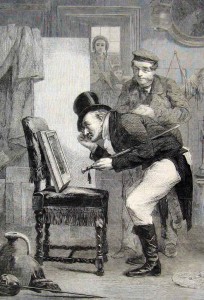Fake or Fortune?
May 12, 2015
Last week I gave a talk at Colet Court, the preparatory school of St Paul’s.
I encouraged the boys to take a closer look at the pictures, maps, family scrap albums and illustrated books in their homes. Most people have got an old print somewhere, perhaps gathering dust in the attic, even if they don’t know it.
I gave the schoolboys some pointers to help identify a genuine antique print, and reproduce them here in the hope that you too, dear reader, might unearth a hidden gem.
Let me know if you come up with any interesting finds. Email a pic here: jasper@jenningsprints.com
Happy hunting!
- Signatures: for an artist to sign a print was rare until the late 19th century, and they also often signed reproductions. Instead, look for Latin terms engraved or etched under the image to denote artist, draughtsman, printmaker, sometimes printer and publisher – in Britain this served as copyright.
- Plate mark: can you see an indented line around the outer edge of the image?
- Paper: does it look bright and new or has it dulled or browned with age? Can you see any rust-coloured spots (known as ‘foxing’)?
Hold the paper close to a light: can you see the pattern of vertical lines (‘wire-marks’) crossed by horizontal ‘chain-lines’ from the wires in the papermaker’s tray. This is evidence of ‘laid paper’, widely used in the 18th century before ‘wove’ papers took over, which have no such marks visible. European papers can be approximately dated from their appearance and feel, and often provide evidence of a modern reprint or facsimile.
- The Image: look closely with a magnifying glass: is it made up of a mesh of tiny dots? If so it may be a photomechanical reproduction.
- Other Clues: if the print is framed, is it an old frame and mount, perhaps with the original framer’s or printseller’s label on the backboard?

